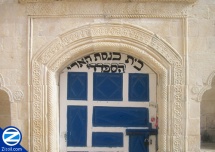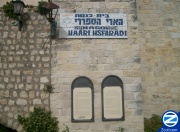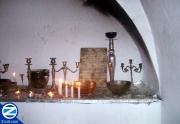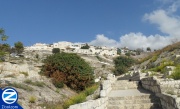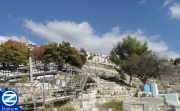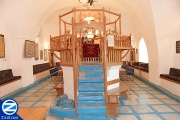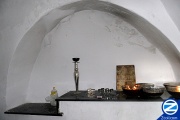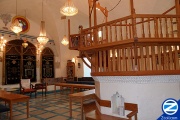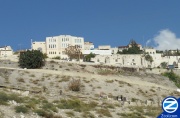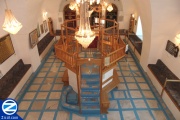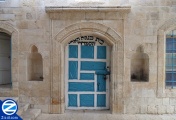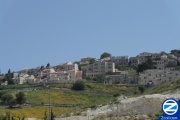Ari Sephardi Synagogue
m (Added Bold formatting to heading) |
|||
| (39 intermediate revisions by 4 users not shown) | |||
| Line 1: | Line 1: | ||
| − | + | {{Infobox | |
| + | |title = Ari Sephardi Synagogue | ||
| + | |image = [[File:00000232 door ari sefaradi.jpg|215px|alt=Ari Sephardi Synagogue]] | ||
| + | |header1 = Hebrew: | ||
| + | |data2 = בית כנסת האר״י ספרדי | ||
| + | |header3 = Spelling: | ||
| + | |data4 = Arei, Hari, Sephardic, Sephardik, Sefardic, Sefardi, Sepharadic, Sepharadi | ||
| + | |header5 = Other Names: | ||
| + | |data6 = Arizal Shul | ||
| + | |header7 = Description: | ||
| + | |data8 = Old Synagogue in Safed, Israel named after Rabbi Yitzhak Luria. | ||
| + | }} | ||
| − | The ARI Sepharadi synagogue is located on HaARI Street just above the ancient Tzfat cemetery. The HaARI Sepharadi is the oldest synagogue in Tzfat, allowing visitors and locals to visit and pray in a spot that encompasses much of Tzfat’s history of the last eight hundred years. | + | The '''ARI Sepharadi synagogue''' is located on HaARI Street just above the [[Ancient Tzfat Cemetery|ancient Tzfat cemetery]]. The HaARI Sepharadi is the oldest synagogue in Tzfat, allowing visitors and locals to visit and pray in a spot that encompasses much of [[Safed History|Tzfat’s history]] of the last eight hundred years. Originally named the Eliyahu HaNavi Shul it was later renamed after the Holy Kabbalist the [[Rabbi Yitzchak Luria|Arizal]] who used to pray there. The ARI Sefaradi was destroyed and later rebuilt in both the [[Safed 1759 Earthquake|1759]] and [[Safed 1837 Earthquake|1837 earthquakes]]. |
| + | == History== | ||
| − | + | [[File:00000137-sign-beit-knesset-ari-sefardi.jpg|thumb|180px|right|Sign at the shul entrance.]]The ARI Sepharadi was built in the 13th century above the [[Ancient Tzfat Cemetery|ancient Tzfat cemetery]]. At that time, the small Jewish community of approximately a dozen families was rebuilding after the defeat of the Crusaders who had [[Crusaders in Safed|ruled the area]] for much of the previous two centuries. They named the synagogue the “Eliyahu HaNavi” -- Elijah the Prophet -- synagogue and the synagogue served as a center of Jewish life as the community grew. | |
| − | The ARI | + | == Rabbi Yitzhak Luria, The ARI== |
| − | + | [[File:00000138L ari sephardi entrance eliyaho hanavi room.jpg|thumb|180px|left|Candles lit in the room.]] [[Rabbi Yitzchak Luria|Rabbi Isaac Luria]], known as The ARI -- The Lion -- arrived in [[Safed|Tzfat]] in 1570. He was already recognized as a renowned Kabbalistic scholar. His presence in Tzfat, alongside that of his students, elevated the city to become the City of Kabbalah, one of Judaism’s four Holy Cities. | |
| − | + | The ARI prayed in the Eliyahu HaNavi synagogue and he also studied Kabbalah in a sideroom of the synagogue. Although the Arizal was Ashkenazi and not Sepharadi, he preferred to pray with a Sephardi minyan since he held their nusach was closer to the original wording created by the Anshi Kneset Hagdola in their attempt to fuse all the 12 tribal variations of prayer. Eliyahu HaNavi himself would come to sit with the ARI and study with him. The prophet would reveal new insights into Jewish mysticism which allowed the ARI to develop and expand Kabbalistic study. His stream of Kabbalah became the “Luranic Kabbalah,” the focus of most of today’s Kabbalah study. | |
| − | + | == Renamed== | |
| + | After the ARI’s death the Tzfat community renamed the Eliyahu HaNavi synagogue after the ARI. Later, congregants of the Grecos Tzfat synagogue also wanted to name their synagogue the “ARI” synagogue The two synagogues differentiated by naming the older synagogue the “ARI Sepharadi”, and the second one the '[[Ari Ashkenazi Synagogue|ARI Ashkanazi]]'. | ||
| − | == | + | == Recent History== |
| − | + | [[File:00000105 top tzfat cemetery.jpg|thumb|180px|right|The Ari Sephardi Shul perched on top of the old cemetery.]]The ARI Sepharadi synagogue was rebuilt twice, after both the [[Safed 1759 Earthquake|1759]] and [[Safed 1837 Earthquake|1837 earthquakes]]. In the 19th century a fear arose that the ARI Sepharadi synagogue was haunted by spirits that would harm anyone unholy who entered. Local residents related that people had entered and never come out. The synagogue was locked and the key held by a caretaker. In 1921 Rabbi Yisrael Abuhatzeira, the Baba Sali, a saintly Moroccan rabbi, visited the synagogue. He persuaded the caretaker to open the synagogue. The caretaker protested but in the end allowed the Baba Sali and his aide to enter. The Baba Sali’s aide later related that the Baba Sali had removed the Torah scroll from its Ark and read aloud until he discerned that the danger had passed. After the Baba Sali’s departure the synagogue once again opened for public prayers. | |
| + | == Today== | ||
| − | + | [[File:00000107 ari sefardi directly above cemetery.jpg|thumb|180px|left|Ari Sephardi Shul directly above cemetery.]]The ARI Sepharadi synagogue is open during the week. Visitors can see the artistically-decorated synagogue, including the room infront of where the ARI sat with Elijah the Prophet and learned Kabbalistic insights. The actual room used by the Arizal has been sealed up, to prevent unworthy people from entering. The synagogue is laid out in Sepharadi tradition with the “Bima” -- the center table -- raised six steps up in the center of the main floor. This custom is derived from Kabbalistic teachings that encourage creating a prayer area that replicates the manner in which the six days of the week lead to the Sabbath. Local artists have contributed their work to the synagogue’s intricate and detailed wall and Ark etchings and paintings. The Ari Sepharadi only has minyonim on Shabbos and holiday mornings. | |
| − | + | == More Pictures == | |
| + | <gallery widths=180px heights=120px perrow=4 caption="Ari Sephardi Synagogue Photo and Image Gallery"> | ||
| − | + | File:00000986 bima ari sepharadi safed.jpg | |
| + | File:00000985 eliyahu hanavi room ari sepharadi.jpg | ||
| + | File:00000987 inside arizal sephardi shul tzfas.jpg | ||
| + | File:00000106 ari sephardi kiryat breslov.jpg | ||
| + | File:00001271 bima ari sepharadi safed.jpg | ||
| + | File:00001535 ari sephardi synagogue door.jpg | ||
| + | File:00001573 beit knesset ari sephardi.jpg | ||
| − | + | </gallery> | |
| + | |||
| + | {{Tzfat Synagogues}} | ||
| + | {{Kivrei Tzadikim}} | ||
| + | {{Safed History}} | ||
| + | {{Safed Spelling}} | ||
| + | |||
| + | [[Category:Old Synagogues]] | ||
| + | [[Category:Safed]] | ||
| + | [[Category:Kivray Tzadikim]] | ||
Latest revision as of 22:00, 26 August 2017
The ARI Sepharadi synagogue is located on HaARI Street just above the ancient Tzfat cemetery. The HaARI Sepharadi is the oldest synagogue in Tzfat, allowing visitors and locals to visit and pray in a spot that encompasses much of Tzfat’s history of the last eight hundred years. Originally named the Eliyahu HaNavi Shul it was later renamed after the Holy Kabbalist the Arizal who used to pray there. The ARI Sefaradi was destroyed and later rebuilt in both the 1759 and 1837 earthquakes.
Contents |
[edit] History
The ARI Sepharadi was built in the 13th century above the ancient Tzfat cemetery. At that time, the small Jewish community of approximately a dozen families was rebuilding after the defeat of the Crusaders who had ruled the area for much of the previous two centuries. They named the synagogue the “Eliyahu HaNavi” -- Elijah the Prophet -- synagogue and the synagogue served as a center of Jewish life as the community grew.[edit] Rabbi Yitzhak Luria, The ARI
Rabbi Isaac Luria, known as The ARI -- The Lion -- arrived in Tzfat in 1570. He was already recognized as a renowned Kabbalistic scholar. His presence in Tzfat, alongside that of his students, elevated the city to become the City of Kabbalah, one of Judaism’s four Holy Cities.The ARI prayed in the Eliyahu HaNavi synagogue and he also studied Kabbalah in a sideroom of the synagogue. Although the Arizal was Ashkenazi and not Sepharadi, he preferred to pray with a Sephardi minyan since he held their nusach was closer to the original wording created by the Anshi Kneset Hagdola in their attempt to fuse all the 12 tribal variations of prayer. Eliyahu HaNavi himself would come to sit with the ARI and study with him. The prophet would reveal new insights into Jewish mysticism which allowed the ARI to develop and expand Kabbalistic study. His stream of Kabbalah became the “Luranic Kabbalah,” the focus of most of today’s Kabbalah study.
[edit] Renamed
After the ARI’s death the Tzfat community renamed the Eliyahu HaNavi synagogue after the ARI. Later, congregants of the Grecos Tzfat synagogue also wanted to name their synagogue the “ARI” synagogue The two synagogues differentiated by naming the older synagogue the “ARI Sepharadi”, and the second one the 'ARI Ashkanazi'.
[edit] Recent History
The ARI Sepharadi synagogue was rebuilt twice, after both the 1759 and 1837 earthquakes. In the 19th century a fear arose that the ARI Sepharadi synagogue was haunted by spirits that would harm anyone unholy who entered. Local residents related that people had entered and never come out. The synagogue was locked and the key held by a caretaker. In 1921 Rabbi Yisrael Abuhatzeira, the Baba Sali, a saintly Moroccan rabbi, visited the synagogue. He persuaded the caretaker to open the synagogue. The caretaker protested but in the end allowed the Baba Sali and his aide to enter. The Baba Sali’s aide later related that the Baba Sali had removed the Torah scroll from its Ark and read aloud until he discerned that the danger had passed. After the Baba Sali’s departure the synagogue once again opened for public prayers.[edit] Today
The ARI Sepharadi synagogue is open during the week. Visitors can see the artistically-decorated synagogue, including the room infront of where the ARI sat with Elijah the Prophet and learned Kabbalistic insights. The actual room used by the Arizal has been sealed up, to prevent unworthy people from entering. The synagogue is laid out in Sepharadi tradition with the “Bima” -- the center table -- raised six steps up in the center of the main floor. This custom is derived from Kabbalistic teachings that encourage creating a prayer area that replicates the manner in which the six days of the week lead to the Sabbath. Local artists have contributed their work to the synagogue’s intricate and detailed wall and Ark etchings and paintings. The Ari Sepharadi only has minyonim on Shabbos and holiday mornings.[edit] More Pictures
- Ari Sephardi Synagogue Photo and Image Gallery
| |||||||||||
| ||||||||||||||
| |||||||||||||||||


